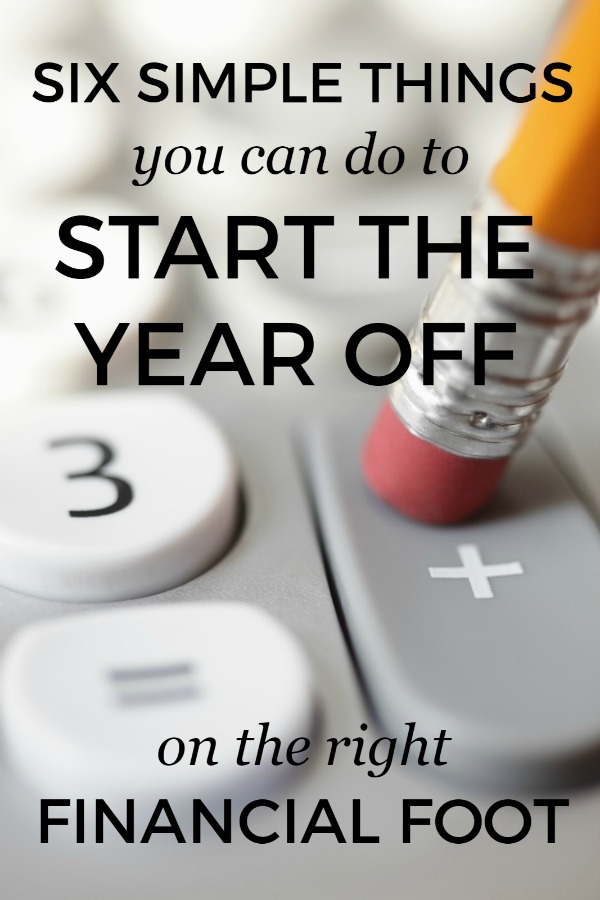
For many of us, the new year brings a renewed desire to get our finances in order. It’s a great time to evaluate the specific items in your budget, but it can be a bit overwhelming.
Where do you start? What line items should you focus on?
Here are six fairly simple things you can do to start this year off on the right financial foot:
1. Set one financial goal for your family or yourself for this year.
Make it something you can accomplish within the next couple of months with a reasonable amount of discipline and effort.
Why start with a goal? Your efforts at cutting expenses and tightening up your budget will peter out without a goal in mind. Why are you cutting out cable? If it’s not to accomplish something more important with the savings, you’ll get irritated real quick and call the cable or satellite company by March. (Read how you can ditch cable or satellite and still watch your favorite shows, including sports, here.)
Here are some ideas: Pay off a debt (I suggest you start with your smallest debt), save for a small summer vacation, get new tires for your vehicle, have enough saved to buy school clothes with cash.
2. Forecast this year’s upcoming expenses and purchases and start saving for them monthly.
Look at last year’s expenses and then make a list of the non-monthly expenses and purchases you anticipate for this year. Estimate the cost of those items (yes, write it down), then count how many months you have until you need to pay for those items. Do the math and put that amount in a separate savings account so you can pay cash instead of freaking out and using your credit card.
Here’s an example (assuming I’m doing the exercise in January):
Anticipated expenses and purchases:
School clothes for the kids — $300 in August = Save $37.50 per month
Life insurance premium — $478 in October = Save $47.80 per month
Spring break vacation — $294 in March = Save $98 per month
Landscaping materials — $200 in May = Save $40 per month
Christmas gifts — $500 in December = Save $42 per month
So January – March I would put $265.30 in my savings account. Starting in April I would recalculate because I’m no longer saving for the Spring Break vacation.
Learn how we use this method of budgeting and have eliminated almost all of our “emergency” expenses HERE.
3. Shop around to see if you can lower your expenses.
Now you could go all out and try to reduce every single expense, but that might push you over the edge (it would for me). Instead, spend your time shopping the best price on some of the bigger ticket items in your budget, like:
- Car insurance
- Life insurance
- Homeowner’s or renters insurance
- Cell/mobile plan
- Cable/satellite/internet
- Household services (house cleaner, lawn service, etc.)
With your insurance plans, make sure you wait to cancel your existing plan until you have paid the first premium payment on the new plan.

4. Evaluate if you want to keep your recurring services around.
This is when you look at your budget items and figure out if you really need them. Think through all the stuff that you get billed for monthly or have a yearly membership to, like:
- Netflix, Hulu Plus, HBO Now
- Amazon Prime
- Costco
- Subscription boxes for clothing, jewelry, accessories, household goods
- Gyms, workout studios
- Apps
- Menu-planning services
And while you’re at it, go into your PayPal account to see if you have any recurring payments in there. It’s easy to cancel those in PayPal.
5. Make a plan for how you’re going to spend last year’s tax return check (if you get a return) BEFORE the check arrives.
Remember, for most of us, that check from the IRS is not found money, it’s money YOU EARNED, so use it wisely. Use the money to help meet your financial goal in #1 or to save for an upcoming expense in #2.
This is also a good time to check your W-4 form to make sure you’re comfortable with the amount that is withheld by your employer for your federal income tax. You can change the numbers so you have a larger paycheck instead of a large tax return in April.
6. Give a gift to express your gratefulness for the money and possessions you have.
Our family does this every month, but it can certainly be done any time as an acknowledgement of the blessings you received last year.
There’s an expression floating around right now (it’s probably old and I’m just clueless): If you have more than you need, build a bigger table, not a higher fence.
I’m going out on a limb and declaring that most of us, if not all, have more than we need. So, what is one thing you can do to build a metaphorical bigger table right now?
Here’s a good place to start: Give to the poor, care for the widow and the orphan, welcome the stranger in your land, visit the sick and those in prison. (Yes, that’s taken directly out of the Bible. It’s good stuff.)
Generosity as a way to express your gratitude always produces good things for everyone involved.
Looking for more resources?
Follow Frugal Living NW on Pinterest!
Fantastic range of boards from best recipes and tips for frugal living to gardening and budgeting help.
This post may contain affiliate links. See the disclosure policy for more information.



Hey Angela, will you be teaching another budgeting course anytime soon?